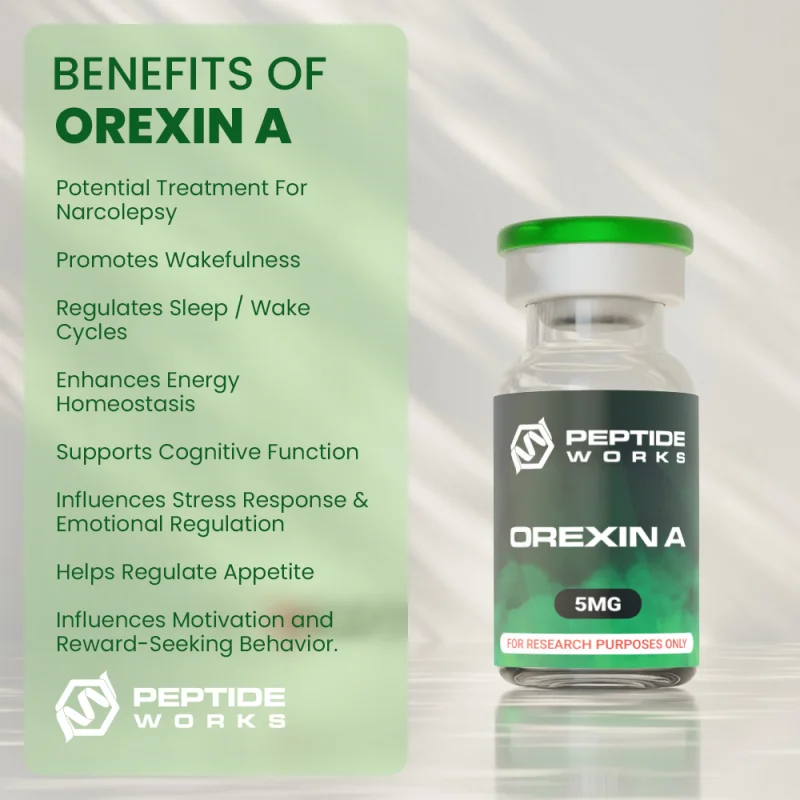PROMO!
First order? Get 10% OFF with this code: 1storder
Our Product Categories

Orexin A (also called hypocretin-1) is a neuropeptide found in the hypothalamus. It helps regulate wakefulness, alertness, and appetite. This neuropeptide works with brain receptors, OX1R and OX2R, to influence functions like energy balance and sleep-wake cycles.
When orexin signaling is disrupted, it can lead to conditions such as narcolepsy, characterized by excessive daytime sleepiness and sudden episodes of muscle weakness known as cataplexy. In addition to its role in sleep, orexin A influences the body’s stress response, reward systems, and metabolic regulation. Its multifaceted role makes it a significant focus in neuroscience and pharmacological research, particularly in the context of sleep disorders and metabolic diseases.
Peptide Sequence (IUPAC Condensed): Pyr-Pro-Leu-Pro-Asp-Cys-Cys-Arg-Gln-Lys-Thr-Cys-Ser-Cys-Arg-Leu-Tyr-Glu-Leu-Leu-His-Gly-Ala-Gly-Asn-His-Ala-Ala-Gly-Ile-Leu-Thr-Leu-NH2
Molecular Formula: C152H243N47O44S4
Molecular Weight: 3561.1 g/mol
Synonyms: hypocretin-1

Orexin A acts as an agonist for two G protein-coupled receptors: the Orexin Receptor 1 (OX1R) and Orexin Receptor 2 (OX2R). These receptors exist throughout the brain, particularly in places that mediate arousal, energy homeostasis, and reward. When the peptide attaches to these receptors, it triggers internal signals, such as calcium release and cyclic AMP production, that increase neuron activity.
Promotes wakefulness and regulates the sleep-wake cycle: Orexin-A is a key regulator of arousal and the sleep–wake cycle. A study on intracerebroventricular administration of Orexin-A in rats increased wakefulness and reduced slow-wave and REM sleep, highlighting its role in promoting alertness [1]. Orexin-A activates wake-promoting neurons in the brainstem and hypothalamus, maintaining long, consolidated awake periods [2].
Loss of orexin neurons causes narcolepsy type 1 in humans, underscoring its physiological importance. Orexin receptor antagonists are now used to treat insomnia, while orexin agonists show promise as future therapies for narcolepsy and other conditions linked to sleep-wake regulation and arousal [3].
Role in energy homeostasis, physical activity and metabolism: Orexin-A plays a significant role in energy homeostasis, physical activity, and metabolism. Research shows that higher plasma Orexin-A levels are linked to increased physical activity and reduced sedentary behavior. In mice, Orexin-A treatment reduced intraperitoneal fat deposits (adiposity) without significantly altering overall energy expenditure [4].
Additionally, Orexin-A production increases with regular physical activity, improving energy and glucose metabolism while modulating thermogenesis. These findings suggest Orexin-A contributes to leaner body composition, enhanced activity levels, and metabolic regulation, positioning it as a potential biomarker for the health benefits of exercise and a target for managing lifestyle-related metabolic disorders [5].
Cognitive / memory enhancement potential: Orexin-A shows potential for enhancing cognition and memory. Animal studies reveal that post-training administration of Orexin-A improves memory retention in avoidance tasks, benefiting both young and aged mice, including those with age-related cognitive deficits linked to beta-amyloid overproduction [6].
Orexin-A’s effects may stem from its role in arousal and hippocampal interactions, as it activates the monoaminergic system, which supports learning, memory acquisition, and cognitive flexibility. Reduced orexin levels are associated with neurodegenerative diseases, while its modulation could offer therapeutic potential for cognitive enhancement and managing neurological disorders, highlighting its importance in higher cognitive functions like attention and memory [7].
Analgesic effects and pain modulation: Orexin-A demonstrates analgesic effects, as evidenced by studies in rodent models of nociception and hyperalgesia. Intravenous Orexin-A demonstrated pain relief similar to that of morphine in hot-plate and carrageenan-induced hyperalgesia tests, functioning through the Orexin-1 receptor (OX1R) and independently of the opioid system.
Orexin-A and OX1R are found in brain and spinal cord areas associated with pain processing, indicating their involvement in nociceptive modulation and presenting opportunities for innovative, non-opioid analgesic treatments [8].
Potential anti-cancer and pro-apoptotic effects in certain cell lines: Research has shown that Orexin-A has potential anti-cancer effects by inducing apoptosis in certain aggressive cancer cell lines, such as colon cancer [9]. Many cancer tissues, including colon and prostate, express orexin receptors, and in vitro studies reveal that Orexin-A triggers apoptosis and autophagy in HCT-116 colon cancer cells via the ERK pathway [10]. These findings suggest a nascent role for Orexin-A in oncology research, though further studies are needed to explore its therapeutic potential in cancer treatment.
[1] D C Piper, N Upton, M I Smith, and A J Hunter (2000) The novel brain neuropeptide, orexin-A, modulates the sleep-wake cycle of rats – European Journal of Neuroscience, 2000 Feb, Volume 12 (Issue 2), Pages 726-30.
[2] K Ohno and T Sakurai (2008) Orexin neuronal circuitry: role in the regulation of sleep and wakefulness – Frontiers in Neuroendocrinology, 2008 Jan, Volume 29 (Issue 1), Pages 70-87.
[3] F Pizza, L Barateau, Y Dauvilliers, and G Plazzi (2022) The orexin story, sleep and sleep disturbances – Journal of Sleep Research, 2022 Aug, Volume 31 (Issue 4), Page e13665.
[4] R Polito, V Monda, E Nigro, et al (2020) The Important Role of Adiponectin and Orexin-A, Two Key Proteins Improving Healthy Status: Focus on Physical Activity – Frontiers in Physiology, 2020 Apr 22, Volume 11, Page 356.
[5] A Blais, G Drouin, C Chaumontet, et al (2017) Impact of Orexin-A Treatment on Food Intake, Energy Metabolism and Body Weight in Mice – PLoS One, 2017 Jan 13, Volume 12 (Issue 1), Page e0169908.
[6] L B Jaeger, S A Farr, W A Banks, and J E Morley (2002) Effects of orexin-A on memory processing – Peptides, 2002 Sep, Volume 23 (Issue 9), Pages 1683-8.
[7] H M Al-Kuraishy, M H Abdulhadi, N R Hussien, et al (2020) Involvement of orexinergic system in psychiatric and neurodegenerative disorders: A scoping review – Brain Circulation, 2020 Jun 26, Volume 6 (Issue 2), Pages 70-80.
[8] S Bingham, P T Davey, A J Babbs, et al (2001) Orexin-A, an hypothalamic peptide with analgesic properties – Pain, 2001 May, Volume 92 (Issues 1-2), Pages 81-90.
[9] N L Graybill and V Weissig (2017) A review of orexin’s unprecedented potential as a novel, highly-specific treatment for various localized and metastatic cancers – SAGE Open Medicine, 2017 Nov 3, Volume 5, Page 2050312117735774.
[10] J Wen, Y Zhao, and L Guo (2016) Orexin A induces autophagy in HCT-116 human colon cancer cells through the ERK signaling pathway – International Journal of Molecular Medicine, 2016 Jan, Volume 37 (Issue 1), Pages 126-32.
The answers to the most frequently asked questions about Orexin A.

Orexin-A is being studied for its link to narcolepsy, a condition often caused by low orexin levels that affect wakefulness and alertness. Scientists are exploring ways to restore orexin signaling in the brain to help manage sleep related symptoms. While findings are encouraging, Orexin-A itself is not an approved treatment and current research focuses on orexin receptor agonists that aim to improve wakefulness and reduce cataplexy in clinical studies.
Orexin-A helps control wakefulness, appetite, and energy use in the body. Studies show it can increase activity levels and influence how the body burns energy. When orexin signaling is low, individuals may feel more tired and gain weight more easily. Researchers are studying how orexin pathways affect metabolism and obesity, but Orexin-A itself is not approved or used for managing weight or appetite.
Orexin-A does not have an established list of side effects because it is not an approved drug for human use. Some early animal studies suggest it might affect alertness, blood pressure, or heart rate, but this is speculative in humans. Long-term safety remains unknown. Scientists continue studying how Orexin-A acts in the brain.
In the United States, Orexin-A is not approved by the Food and Drug Administration (FDA) for medical or therapeutic use. It may be purchased for laboratory research purposes when labeled for research use only. Buyers should ensure all purchases follow U.S. regulations and compliance standards for scientific materials. Laws and import rules may differ between regions and countries, so it’s best to verify local requirements before ordering.

This blog delves into the potential of Orexin Addiction Therapy, exploring how the neuropeptide orexin influences cravings, motivation and reward pathways in the brain. It examines cutting-edge research on orexin receptor antagonists, their role in reducing relapse risk and the interplay between orexin and oxytocin in addiction and stress regulation.

This blog explores the science behind the Orexin A peptide and its potential to help reduce daytime fatigue. It looks at how this brain signal regulates wakefulness, focus, and energy balance and examines its links to conditions such as excessive daytime sleepiness and narcolepsy. The article also compares Orexin A with DSIP, highlighting their different roles in sleep and energy regulation.

This blog explores the science of sleep peptides, including DSIP and Sermorelin, and their potential to improve sleep quality. It looks at how these compounds support deep sleep, maintain neurotransmitter balance, and aid recovery, with growing research to back their effects. Learn how these peptides could transform sleep science and promote restorative, healthy sleep cycles.
ALL CONTENT AND PRODUCT INFORMATION AVAILABLE ON THIS WEBSITE IS FOR EDUCATIONAL PURPOSES ONLY.
DISCLAIMER: These products are intended solely as a research chemical only. This classification allows for their use only for research development and laboratory studies. The information available on our Peptide Works website: https://peptide-works.com/ is provided for educational purposes only. These products are not for human or animal use or consumption in any manner. Handling of these products should be limited to suitably qualified professionals. They are not to be classified as a drug, food, cosmetic, or medicinal product and must not be mislabelled or used as such.